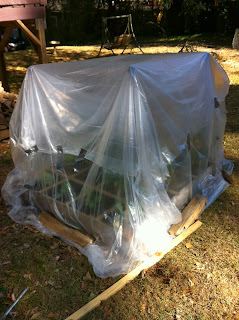 |
| This is what my cauliflower looked like last week. Now they're gone. |
I can only assume that the deer took my cauliflower from me in the cover of night. What else would eat a whole plant, thick stem and all, right down to the ground? I used to love watching the deer. From my living room, I could see them grazing on the weeds in our back lawn when I worked at home. I felt like Snow White living among the cute, fuzzy animals. Other than losing one bean plant in the spring, they hadn't touched the vegetable garden in months. Now, I have one cauliflower plant left. It's really kind of heartbreaking. If I'm lucky, I might get one crown of cauliflower for all my work. Clearly, Snow White never had a vegetable garden.
You better believe I'm caging my garden now. I built the cage in the spring originally to keep the deer out and to keep the squirrels from digging among my seedlings and disturbing them. When the plants grew too large for the cage, I left it off, and the deer really left my garden alone. When the freeze came last week, I put up a PVC frame with plastic sheeting to protect the cauliflower from frost, and when the plastic came off, I left the frame up for ease of covering when the next freeze hits this weekend. Apparently, I need to remove the frame and replace it with the cage in between freezes. That last cauliflower plant will stay covered at all times.
You better believe I'm caging my garden now. I built the cage in the spring originally to keep the deer out and to keep the squirrels from digging among my seedlings and disturbing them. When the plants grew too large for the cage, I left it off, and the deer really left my garden alone. When the freeze came last week, I put up a PVC frame with plastic sheeting to protect the cauliflower from frost, and when the plastic came off, I left the frame up for ease of covering when the next freeze hits this weekend. Apparently, I need to remove the frame and replace it with the cage in between freezes. That last cauliflower plant will stay covered at all times.
 |
| For now, my last cauliflower plant lives safely under a cage. |
The moral of the story: if you have deer in your neighborhood, don't ever let your guard down, especially in the winter time when their natural food supply is more scarce. My cage works fine for my little garden, but I'm not sure what people with larger gardens do. I never had these issues growing up in suburban south Florida. Do you have any suggestions?










